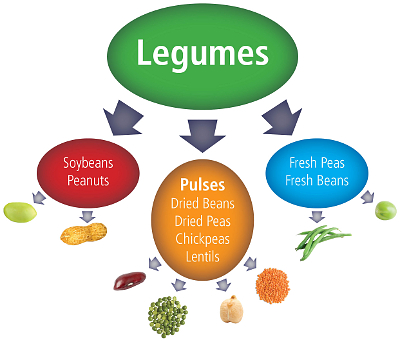The 68th UN General Assembly declared 2016 the International Year of Pulses (IYP)
(A/RES/68/231).

The Food and Agriculture Organization of the United Nations (FAO) has been nominated to facilitate the implementation of the Year in collaboration with Governments, relevant organizations, non-governmental organizations and all other relevant stakeholders.
The IYP 2016 aims to heighten public awareness of the nutritional benefits of pulses as part of sustainable food production aimed towards food security and nutrition. The Year will create a unique opportunity to encourage connections throughout the food chain that would better utilize pulse-based proteins, further global production of pulses, better utilize crop rotations and address the challenges in the trade of pulses.
Pulse: from the Latin puls meaning thick soup or potage, pulses are the edible seeds of plants in the legume family.
Pulse vs. Legume - What's the Difference?
· Legume:
The term "legume" refers to the plants whose fruit is enclosed in a pod. The review of the most outstanding species of 46 genera of the family Leguminosae (Fabaceae) is given here. This third family on size includes of 23 535 species united in 917 genera according to our data. When growing, legumes fix nitrogen into the soil, which reduces the need for chemical fertilizers. Well-known legumes include alfalfa, lupins, clover, fresh peas, mesquite, soy and peanuts.
· Pulse:
Pulses are part of the legume family, but the term “pulse” refers only to the dried seed. Dried peas, edible beans, lentils and chickpeas are the most common varieties of pulses. Pulses are very high in protein and fiber, and are low in fat!

Like their cousins in the legume family, pulses are nitrogen-fixing crops that improve the environmental sustainability of annual cropping systems.
Pulses are essential crops for a number of reasons. They are packed with nutrients and have a high protein content, making them an ideal source of protein particularly in regions where meat and dairy are not physically or economically accessible. Pulses are low in fat and rich in soluble fibre, which can lower cholesterol and help in the control of blood sugar. Because of these qualities they are recommended by health organizations for the management of non-communicable diseases like diabetes and heart conditions. Pulses have also been shown to help combat obesity.
For farmers, pulses are an important crop because they can be both sold and consumed by the farmers and their families. Having the option to eat and sell the pulses they grow helps farmers maintain household food security and creates economic stability. Furthermore, the nitrogen-fixing properties of pulses improve soil fertility, which increases and extends the productivity of the farmland. By using pulses for intercropping and cover crops, farmers can also promote farm biodiversity and soil biodiversity, while keeping harmful pests and diseases at bay.
Pulses can contribute to climate change mitigation by reducing dependence on the synthetic fertilizers used to introduce nitrogen artificially into the soil. Greenhouse gases are released during the manufacturing and application of these fertilizers, and their overuse can be detrimental to the environment. However, pulses fix atmospheric nitrogen in the soil naturally, and in some cases free soil-bound phosphorous, thus significantly decreasing the need for synthetic fertilizers.
I was fortunate enough to explore the pulses in Russia and Finland for more than 40 years. The main objectives of my scientific activity of where the collection and study of Plant genetic resources (soya, beans, peas, lentils, chickpeas, cowpeas, faba beans, lupins) as initial material for plant breeding. I have participated in 15 plant collecting missions, explored different regions of former USSR (Siberia, Far East, Kazakhstan, Caucasus, Middle Asia, Ukraine) and many others countries (Brazil, Peru, Argentina, Ecuador, Algeria, Portugal, Germany, Poland, Iceland) and has collected a wide diversity of leguminous plants and their wild relatives, which are effectively used in Plant breeding in Poland, Finland, Belarus, Russia and in many other countries.

Acquaintance with the genetic resources of Cowpea in Brazil, 1987 year
I headed the Department of leguminous plants in the Russian N.I. Vavilov Institute (VIR) in St. Petersburg for many years. Founder of the Institute Nikolai I. Vavilov (1887–1943) is recognized as the foremost plant geographer, botanist and geneticist of contemporary times. In the early 20th century, the world did not appreciate the urgency of protecting the environment and scientists thought little about the gradual disappearance of valuable plant species. Vavilov was among the first to recognize the need for intensive plant collecting, research and preservation. He organized and took part in over 100 collecting missions in the major agricultural areas of the world. During these expeditions, Vavilov paid special attention to leguminous crops as sources of protein and as means of increasing soil fertility (Sinskaja 1991). He considered these issues to be of the highest priority in biological and agricultural sciences for developing sustainable agricultural production. Many close colleagues of Vavilov e.g. Barulina (his second wife), Govorov, Zhukovsky, Sinskaja further developed his ideas, selecting legumes as the subject of their research. Review of performed research by me and my colleagues research presented here.
The results of our research are presented in the pages of this site. The FAO initiative to declare 2016 the International Year of Pulses is very useful and timely!